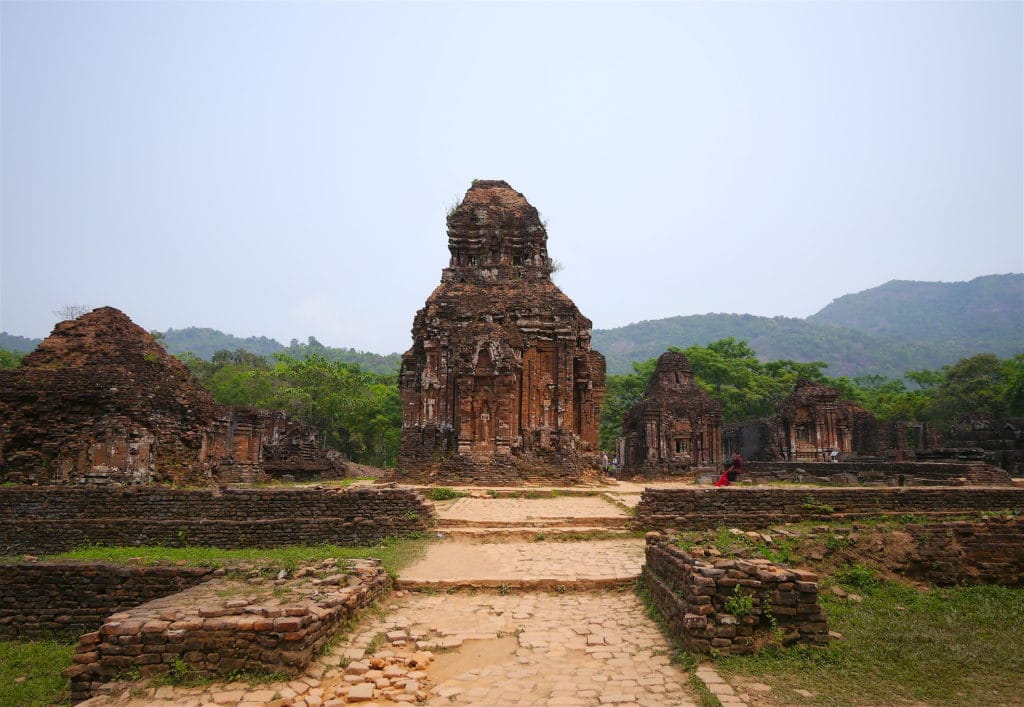The ancient site of My Son, in Central Vietnam, near Da Nang, is a group of Hindu temples built between the 4th and 14th centuries. The temples were devoted to the God Shiva and can be visited on a walking tour.
The site is unfortunately not very well preserved and was badly damaged during a single week during the Vietnam War when bombs were dropped indiscriminately. What is left is reminiscent of the Ancient Civilisations of Anaradhupura and Polonawara in Sri Lanka, which can be visited on a road trip along the Cultural Triangle.
The site is located in the jungle, hidden between two mountain ranges on a valley. It was a religious place where ceremonies for the royal dynasties of Champa who ruled in the area were carried out. At its climax, My Son included 70 temples and it is believed to be the longest inhabited archaeological site in Indochina. As a prominent Hindu complex, My Son can be compared to other grand religious structures also recognised by UNESCO such as Bagan in Myanmar, Angkor Wat in Cambodia (where destination weddings are amazing!) or Borobudur in Indonesia.
What made My Son fascinating was the mixture of Sanskrit and Cham languages, used interchangeably. The temples and tombs were erected first by King Bhadravarman who built a stele or marker with an inscription that indicated that the valley was devoted to himself. In it, Bhadravarman asks his successors: “Out of compassion for me do not destroy what I have given.” and added a conclusion drawing from karma philosophies, “If you destroy [my foundation], all your good deeds in your different births shall be mine, and all the bad deeds done by me shall be yours. If, on the contrary, you properly maintain the endowment, the merit shall belong to you alone.”
The temple built by King Bhadravarman was destroyed by fire but King Sambhuvarman rebuilt in the 7th century and erected a new steel to record the event and reinstalled the god under the name Sambhu-Bhadresvara. That temple was also destroyed during the Vietnam War in the 20th century and cannot be seen today.
With the fall of the Champa rule My Son fell into oblivion and was only rediscovered in 1898 by a Frenchman. First studies on the inscriptions and the ruins were published in the beginning of the 20th century.
Today, My Son can be visited on a short walking tour. Car can be parked at the entrance and buggies bring visitors closer to the temple structures. There aren’t many signs or explanations on the site so taking a guided tour is worth it. A map indicates that the main constructions are grouped under 6 groupings, A, B , C, D, E, F, G, H.
What I found most fascinating about My Son is the lack of understanding, until today, on the constructions techniques used. The buildings were made of red bricks but there is no visible matter binding the bricks together. Scientists still don’t know how that was done or when the bricks were cooked in the fire. There isn’t a clear understanding either as to when and how the carvings were done. Recent reconstruction done as part of the UNESCO efforts and founded by various international governments are visible on the constructions. Parts of My Son are very similar to what can be seen in Angkor Wat with temples, stupas and Stone Lingas scattered around.
My Son can be relatively crowded during peak hours and very hot in the heat of the day (with limited shade) so go early, as the sun rises, leaving Hoi An at 6am, and enjoy the cooler breeze and the peacefulness of the place. Or, if you are staying at the fabulous Banyan Tree Lang Co, do like we did and go later, leaving the hotel at 10,30am, visit My Son first, when it is not crowded anymore (though bring an umbrella for the sun) and then head to Hoi An for a late lunch and an evening in the romantic lantern filled UNESCO town. Check out my article on the best beaches in Vietnam to see which are nearest to Hoi An.
